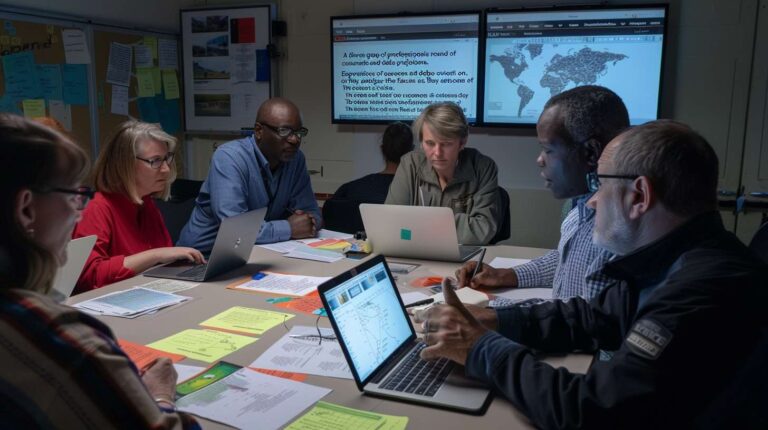A Complete Guide to Tabletop Exercise Design – Design (2/4)
Tabletop Exercise Scenario Development
A compelling exercise design is the foundation for an immersive and engaging experience. The design should fit the purpose and objectives established during the planning phase. Creating a realistic and relevant context is key. It lets participants explore and practice their response strategies is paramount.
The scenario serves as the backbone that supports the entire experience. It provides the context and challenges that participants will navigate. As you develop the scenario, focus on three key elements: realism, relevance, and inclusion.
Realism
A training exercise prepares your organization for ‘the worst day.’ As such, you need to build a realistic scenario. If you start talking about a zombie invasion, you miss the point. Your participants will leave frustrated and not better equipped to handle crises.
Research your scenario and mirror real-world case studies and examples from your industry. For instance, if you’re preparing for a data breach, research the expected data loss and understand the potential economic impact based on other comparable organizations.
As a designer, you should understand the consequences of your crisis more than anyone else in your organization. Become a subject matter expert with data to support your scenario design.
Relevance
The challenges you create should be relevant to the stakeholders. They need the authority to take action on the scenario you build.
Consider you’re designing an exercise for your communications team. If your scenario involves an element your legal counsel would lead in a crisis, you must account for that. You may need to simulate a response from legal. Of course, consult your legal team in advance on their response to the situation.
Empower your training audience to engage with the scenario as they would in a real crisis. They need to affect change and hone their problem-solving skills.
Inclusion
Include stakeholders that would play a role in a real-world response. Don’t discount their role if they cannot attend and engage in the exercise. Don’t ‘skip’ over anyone in the exercise. Recognize absent stakeholders and articulate their roles to the participants.
Response planning in silos is the quickest way to disaster.
Prioritizing realism, relevance, and inclusion creates an environment for an impactful tabletop exercise.
Master Scenario Events List (MSEL)
Terms
Developing an effective MSEL is crucial for ensuring a cohesive and engaging experience. It transforms the overarching scenario into an immersive narrative. It presents realistic challenges that test participants’ skills, decision-making abilities, and preparedness.
Align each element with the exercise objectives, balancing structure and flexibility. Incorporate open-ended prompts to encourage critical thinking. Ensure each detail contributes to the flow and appropriate level of challenge.
In the following sections, we’ll explore critical considerations for developing an impactful MSEL. We’ll cover objective alignment, open-ended prompts, and inject anatomy. Understanding the parts of an inject will make writing them much easier.
Objective Support
By now, you should have the Purpose and Objectives clarified. If you’re still unsure, consider what you’d like to achieve in the exercise. Solidify those things before diving too deep into the inject design.
The MSEL should bridge the scenario narrative to the exercise objectives. Each event, inject, or prompt in the MSEL should support one or more specific objectives.
Open-ended Prompts
Empower your audience to effect change as they resolve the challenges you present. Create space for critical discussions about new information.
As you craft your injects, make the ‘action’ associated with the inject ambiguous. The participants should use every stakeholder at the table to meet the objective. Be intentional with your inject design to drive discussion, not explicit action.
Rigid, linear injects don’t inspire growth. Design open-ended prompts that introduce ambiguity, complexity, or conflicting priorities. Injects should require participants to navigate through uncertainty and make informed decisions.
When developing open-ended prompts, consider the following approaches:
Introduce Ambiguity
Craft injects that present incomplete or conflicting information. Force participants to analyze the situation from multiple angles. They should fill in knowledge gaps through collaborative discussion.
Present Competing Priorities
Use prompts that highlight conflicting priorities and resource constraints. Force participants to weigh trade-offs and make difficult decisions.
Challenge Assumptions
Design challenges participants’ assumptions or preconceived notions. Encouraging them to question their initial perspectives and consider alternative viewpoints.
Foster Collaborative Problem-Solving
Develop prompts that need input and perspectives from various stakeholders within the exercise. Fostering interdepartmental collaboration and knowledge-sharing.
Encourage Creativity
Introduce prompts with no clear-cut solution. This prompts participants to think creatively and develop innovative approaches.
By incorporating these open-ended prompts, you create an environment that encourages critical thinking. It forces problem-solving and adaptability—essential for navigating the complexities of real-world crises. Empowered participants can explore different perspectives and engage in meaningful discussions. They can develop a deeper understanding of the nuances of crisis.
Inject Anatomy
You’re well on your way to a practical exercise that will make a difference in your organization. Let’s introduce a bit of structure for your inject development. This framework will clarify priorities and make the injects flow more easily.
I use a spreadsheet to build our MSEL. Let’s standardize each header column to represent one element of our inject. You’ll find it much easier to fill in the blanks than to think of every detail in a paragraph.
I borrow my general design structure from the Homeland Security Exercise Evaluation Program, though their eact structure is generally more complex than my use cases.
I invite you to use my blank MSEL template.
MSEL Column Headers
Breaking the inject structure into these parts creates a streamlined process. It provides exercise controllers with all the needed information.
Tabletop Exercise Materials
Now you have a well-crafted scenario and a structured MSEL. Your next step is to make sure it’s organized. We’ll develop critical documents that will standardize your design and streamline delivery.
Investing time and effort into these materials enhances the quality of the exercise. It ensures participants immerse themselves in the scenario. It will make the evaluation process clear. Additionally, exercise materials make your job on execution day a breeze.
We’ll break the exercise materials into three components. They are the Participant Manual and the Facilitator’s Guide.
Participant Manual
The Participant Manual provides background information, scenario details, and reference materials. This information will allow participants to engage with the tabletop exercise. A well-designed manual helps participants understand their roles and responsibilities. It also provides the environment in which they will be operating.
When developing the Participant Manual, include the following elements:
Exercise Overview
This overview outlines the exercise objectives, scenario overview, and relevant background information. This introduction provides an overview of the purpose and scope of the exercise.
Participant Roles and Responsibilities
Define the roles and responsibilities of each participant or stakeholder group. This section should outline their expected contributions.
Scenario Narrative
Write a detailed scenario overview. While this should not reveal everything happening, it should provide adequate scenario context. Ensure this is engaging and immersive. It should transport participants and allow them to visualize the scenario.
Supporting Materials
Incorporate relevant reference materials. These might include organizational charts, facility layouts, or existing policies or procedures. You may also include subject matter expert briefings that will matter later. These materials should provide the information needed for informed decisions during the exercise.
The Participant Manual empowers participants to engage with the exercise scenario. Cut corners here, and the effectiveness of your exercise will drop. You want your participants to contribute meaningful discussions to the exercise. Help them make profitable decisions by providing them with a clear document.
Misunderstanding the scenario should not be one of the challenges in the exercise.
Facilitator’s Guide
The Facilitator’s Guide is your exercise execution script. This is the facilitator’s primary reference throughout the entire exercise lifecycle. It covers everything from pre-exercise planning to post-exercise evaluation and debriefing.
Write the guide so that you are not crucial to the exercise. If you are unexpectedly absent on the day of the exercise, someone should be able to step into your place. This is how detailed and clear your guide should be.
Here are some things you should include.
Exercise Overview
Provide a detailed overview of the exercise. Include the purpose, objectives, scenario summary, and relevant background information. Of course, you can repurpose the Participant Manual and Controller Scripts here. But, this overview should contain more detail that will be helpful as a facilitator.
Include things like the data you researched in your preparation here. This information may be useful during the discussion, so keep it handy.
Facilitator Roles and Responsibilities
Outline the facilitator’s role and responsibilities. They must manage the exercise flow, guide discussions, and enforce exercise rules.
Pre-Exercise Planning and Preparation
Include guidance on pre-exercise tasks. Facilitators should deliver an exercise brief to the participants before the exercise. The outline and agenda for that brief exist in this section.
Also, include details about setting up the exercise environment. If you will need equipment to display multimedia, make sure you include that here. If you need a key to the exercise room, include that here. This serves as your pre-flight checklist if you will.
Exercise Structure and Agenda
Provide a detailed agenda or timeline for the exercise. Include the sequence of events, scheduled breaks, and approximate durations for each phase. This section should align with the MSEL.
Facilitation Techniques and Best Practices
This section offers facilitation techniques, tips, and best practices. Remember, a facilitator should not be the most crucial element of a tabletop exercise. Ensure this section prepares anyone to step into the facilitator role.
Evaluation and Assessment Processes
Include evaluation forms, checklists, or rubrics to assess participant performance. Provide an avenue to identify strengths and areas for improvement. Detail how you will gather feedback on the exercise’s effectiveness. Guide how to interpret and use the evaluation data.
Post-Exercise Debrief and After-Action Review
Include guidelines for conducting the post-exercise hot wash and after-action review. This section should outline procedures to lead discussions on lessons learned. It should provide space to record best practices and recommendations for future improvements. It should also outline processes for compiling and disseminating an after-action report.
Exercise Rules and Guidelines
Define the rules and guidelines that participants must follow during the exercise. This is a good place to note the artificialities that exist in the exercise. Encourage participants to ‘play the game’ instead of poke holes in the scenario.
Detail any specific communication protocols participants need to follow. For instance, you may want to restrict the use of company email to keep the exercise isolated. If that’s the case, make sure you provide an alternative communication method.
Contingency Planning
Explain how to handle unexpected situations or disruptions during the exercise. If there are technical issues, what is the alternative? What is the threshold for participant absences before you postpone the exercise? What will constitute a deviation from your scripted scenario? This section should outline procedures for adapting and maintaining exercise continuity.
A masterfully built Facilitator’s Guide will enable focus on leading the conversation. You don’t want a facilitator struggling with the next steps in the exercise. This sacrifices crucial conversation. Do yourself (or your facilitator) a huge favor by creating a polished script.
Tabletop Exercise Design Conclusion
As we wrap up the design phase, remember that every piece of this puzzle is intentional. Each inject has a specific purpose for the exercise. You are leading your team toward resilience and proactive crisis readiness. Your curated scripts, guides, and controls should integrate all elements.
Next up is the Execution phase, where planning meets practical. In this stage, we’ll direct a simulated scenario and see your team in action. We’ll discuss everything from setting up the stage to closing the exercise.




